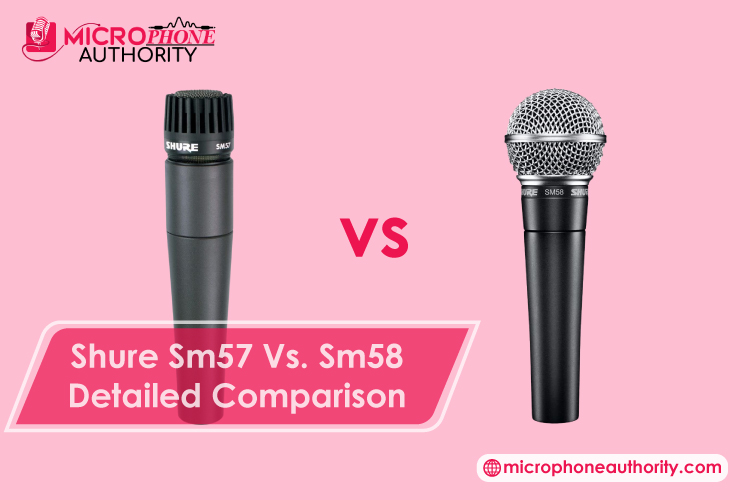Last Updated on May 27, 2023 by Robert Mejia
Both the Shure SM57 and the SM58 are popular microphones and are handy applications from studios to live presentations.
There are relatively few differences between the Shure SM57 and SM58. In general, the two receivers are very similar; in fact, they are practically indistinguishable.
While the Shure SM57 is designed for artists, the SM58 is custom-made mostly for recording vocals. The even cardioid pattern allows every sound to be obtained clearly and uniformly.
Either way, they excel at relaying quality sound, regardless of their application.
The Comparison Table

Shure-SM57

SM58
Shure SM57 vs. SM58 Application
The SM57 is the most appropriate mic in a studio setup. If that is the reason that you need a mic for, then you are in for a memorable recording experience with the SM57.

On the other hand, the Shure SM 58-shaped frequency reaction smoothers out the sound production, enabling a much smoother recording to an ideal sound quality. With a focus on catching quality vocals, the SM58 additionally has a pneumatic mount.
Shure SM57 vs. SM58 Similarities

Polar Patterns
Both the Shure SM57 and SM58 are designed with a cardioid pattern. The section of the microphone’s various angles is generally heart-shaped. For that reason, it gets the cardioid name. However, in reality, it appears like a vertical cross-section area of an apple, with the tail being the back of the pattern. The cardioid or the unidirectional design is broadly used to single out sounds showing up from the sides or end of the mic.
Shure SM57 vs. SM58 Differences
Design and Structure
The exterior design is among the distinguishing features between the two models.
Though the two microphones contain a grille, the SM58 grille is more prominent than that of the SM57 one and is more likely to capture the sound details of any vocal presentation. It also possesses a built-in pop channel to limit plosives and other undesirable sounds from recordings.
The SM57 has a small grille that includes a resonator and grille put together to avoid any potential vocal blemishes that get their way through. The grille in the SM57 makes a piece of the cartridge
Connectivity
The SM57 exclusively works when it is connected to a wire. The SM58 can work with or without a wire connection. Extra parts would be necessary to make this work. However, if you are allowed to move around when making a presentation, a speech, or any other live performance, the SM58 is the receiver you would require. There are wireless versions of the SM58 microphones
The SM57’s increasingly fixed structure would most likely make matters difficult and upset your manner of thinking.
Shure SM57 vs. SM58 Advantages
Both the Shure SM57 and SM58 are durable pieces of equipment and have undergone rigorous testing
Another exciting factor adding to the SM57’s life span is its resistance to dampness and high temperatures. These natural changes ordinarily occur during transportation and storage. The mix of these two conditions can cause undesirable noise, for instance, crackling and popping.
It is easier to record loud volumes since they have next to zero electronics or incorporated circuits. They can take a great deal of weight and continue to transmit voltage. The Shure SM57 and SM58 microphones are indestructible.
Frequency Response
Generally, a microphone reacts to sound waves from their diaphragms, changing over the airwaves into audio signals. The sound usually shows frequencies of 20 Hz – 20,000 Hz. The SM57 mic has a frequency reaction of between 40 Hz to 15 kHz. That implies the SM57 will adequately reproduce sounds in the scope of 40 Hz to 15,000 Hz. The mic will be able to produce sounds on frequencies in its mic signal.
Whereas the frequency range of the SM58 mic is between 50Hz and 15,000 Hz.
Sound Pressure Levels (SPL levels)
Practically, there is no restriction on the high steady sound levels (SPL) the SM57 can manage. In all honesty, no sound is too powerful for it to handle. The frequency range that may cause disturbance is around 100Hz at 150dB SPL. That is louder than the sound of a jet engine. At 20 kHz, the SM57 can speculatively manage around 190dB SPL.
That is the reason why dynamic microphones are so appropriate for recording things such as guitar amps. The user can adjust the volume to be amazingly high volumes and record all the force that an amp can deliver without worrying that the microphone might distort the signal.
Both the Shure SM57 and SM58 are well-developed and can be relied upon to perform well daily. Since they are both dynamic microphones, they are less susceptible to noise caused by wind. That is due to the dense mass of the dynamic diaphragm.
Bottom line
Both of the Shure SM57 and SM58 make comparably attractive offers. They’re reliable, sensible, and produce an incredibly exceptional sound.
Regardless, their development and design imply that your decision indeed relies upon what you intend to do with the microphone.





